UC Berkeley Web Feature
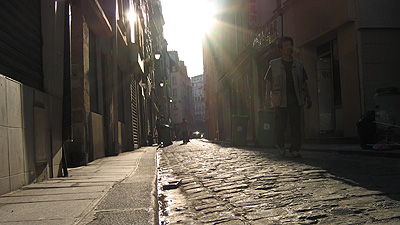 |
Rue
au Maire at sunset. This 3rd arrondissement
street leads
past four Chinese restaurants, “Baghdad
Café,” and a laundromat to a Vietnamese
restaurant. (Photos by Gene Tempest except where noted) |
Arriving in Paris, and glimpsing the ghosts of protests past
| About Student Journal 2006 [an error occurred while processing this directive] |
Rue des Gravilliers is one of those narrow, perfect Parisian streets — this one in the 3rd arrondissement — on which you could live well by never leaving. It has a butcher whose crispy chickens roast outside, a bakery with fresh baguettes and unmanageably large macaroons, a fruit stand with ripe melons and figs bigger than a baby's fist and much sweeter, too. It has many cafés, tabacs, and Chinese restaurants, a trendy bar somewhat strangely named "Andy Wahloo," Iraqi and Moroccan sit-down places, a Greek sandwich stand, handbag stores and art galleries ... Rue des Gravilliers speaks Chinese (Mandarin and Cantonese both), Vietnamese, French, accented French, and — some late Friday nights when my neighbors are finishing their revelry — Rue des Gravilliers sings accented but honest and well-meaning Michael Jackson songs.
I knew at once that the street was full of magic and promise; my agenda, on the other hand, was terrifyingly blank.
I had come to Paris to research my History senior thesis, "Anti-Nazism and the Atelier Populaire: The Memory of Nazi Collaboration in the Posters of Mai '68." My project required that I interview artists who, almost 40 years ago, occupied their art schools and printed thousands of posters during the French version of the international student and worker unrest of the late 1960s. Oh, I did have a couple things written on my calendar — "leave SFO," "arrive CDG" and then, in blue ink, "apartment, 12h00" — but not much else.
 The author at work on an interview guide in her apartment. (Morgan Gilman photo) |
|
 The Arts et Métiers metro stop is the best way to arrive at 76 Rue des Gravilliers. |
|
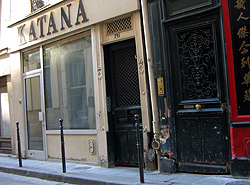 No. 76 is next to a Chinese restaurant and a handbag store. |
|
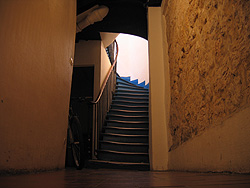 The ground floor, or rez de chaussée. |
|
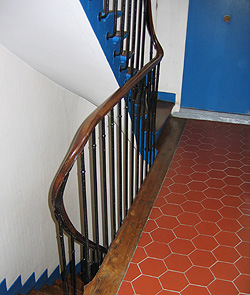 The blue door on the third floor. |
|
 The apartment’s main room. Visible rafters are one of the beauties of old Paris. |
Today, almost a month later, my little navy pocket calendar, a Christmas gift from State Farm insurance agent Beth A Rumph of Texas, is full of appointments and interview times, coffee dates and dinners, friends leaving and arriving, World Cup matches and scores, and, every Friday, a note that the Louvre is free from 18h00 to 22h00 for those less than 26 years old.
But none of these things had been written down when I stood in front of my blue apartment door for the first time. My landlord, Monsieur B., opened the door and I discovered that it is only blue on the outside. In fact, all the doors in my building are blue. On the first floor, the tenant has hung a little red glitter star on his door. The blue door on the second floor has a peephole, and its tenant, I would later learn, often plays keyboards, smokes marijuana, and leaves his underwear on his window sill.
Monsieur B. is one of those men who, to the young, will always be of ambiguous age. Perhaps in his mid-40s, possibly in his early 60s, he shook my hand and then introduced me to my new home.
The apartment is a studio, and on the back of the blue door, which is cream-colored, there is a poster from the French release of "Walk the Line." It shows Joaquin Phoenix and Reese Witherspoon, and reads "DU FEU DANS LES VEINES." It was left by the previous tenant, a singer from Canada. She also left behind a book on the Moscow art fair, "A Shopper's Guide to Paris Fashion," a play (Molière's "L'Avare"), emergency phone numbers for the 3rd arrondissement, two packets of oatmeal, which I later ate, and some coffee, which I later drank. It is strange to think that, before me, she lived here. Apartments are just shells, I suppose, but they never seem like shells when you live in them. They are always homes then. I do wonder what I will leave or forget here, and how I will change the place, and how it has changed me.
The main room, a bedroom-living-room-dining-room-office, was introduced at great length. Monsieur B. invited me to unfold the futon twice. He then gave me very earnest advice on the possible pairings of sheets and pillow cases. "You will want to pair this sheet with this pillow cover," he said, extricating continents of earth-colored cloth from the closet. His brow furrowed. "Unless you want to use this kind of pillow, in which case you will want to use the other sheet. You see?"
That first night I went for a walk. I went for a walk to get out into the city a little, and to forget my already-suffocating academic anxieties. Research will begin tomorrow, I told myself.
But darling Paris is such a gracious hostess! Research began, informally and perfectly, that night. In her great generosity, Paris gave me two posters and a graffito (scroll below to see pictures). All three were direct descendants of 1968.
One poster reused the fist in the way that the 68ers had drawn it. The other poster, against the CPE (a fight in which students struck and led the confused American press make comparisons to 1968), is a re-interpretation of the famous "Sois Jeune et Tais Toi" ("Be Young and Shut Up") poster.
The graffito read "CRS SS." This code was written on walls in 1968, shouted at protests, and printed on posters. The CRS were and are the French riot police; the SS were the Nazi storm troopers. Such associations between the two were exactly what I had come to Paris to investigate.
Walking the streets of Paris — well, you can FEEL the History. It's almost creepy, like knowing that a few days ago my apartment was not MY apartment but the apartment of a Canadian singer, who lives here still in her oatmeal and books on Moscow.
Paris is Memory, and Parisian walls obviously still remember the posters of 1968.
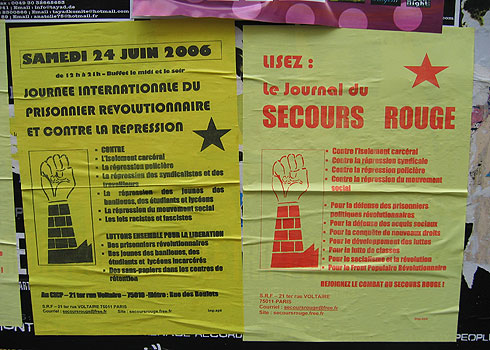 |
||
 |
Above:
|
|
 |
Left: This CRS (Compagnies Républicaines de Sécurité) and SS (Schutzstaffel) graffito at 33 Rue du Temple is a direct descendent of 1968. Similar graffiti could be found in the Latin quarter and on several posters in May and June almost 40 years ago. Denouncing the "fascist" character of the forces of order was a typical late-1960s outcry. |
|
